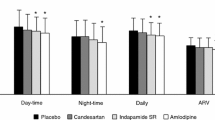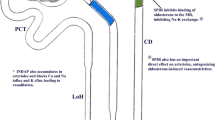Summary
Nifedipine interactions in hypertensive patients have been evaluated, taking into account both the possibility that the inhibition of prostaglandin (PG) synthesis induced by non-steroidal antiinflammatory drugs (NSAIDs) can reduce the antihypertensive effect of nifedipine and the interactions of nifedipine with other antihypertensive drugs. While the inhibition of systemic and renal PG synthesis induced by indomethacin reduces the hypertensive effect of many drugs, it does not change the antihypertensive effect of nifedipine.
The combination of two antihypertensive drugs with different mechanisms of action is often needed in the treatment of hypertensives, since it is well known that monotherapy is able to normalize BP in no more than 50% of mild to moderate hypertensives, and the rationale to combine two antihypertensive agents is based on the knowledge that their combination exerts an additive antihypertensive effect when compared with single-drug treatment. While it is well established that nifedipine can be usefully combined with beta blockers. ACE inhibitors, and clonidine, it is still controversial whether the combination of nifedipine with a thiazide diuretic exerts an additional antihypertensive effect.
We have previously shown that the acute hypotensive effect of nifedipine in patients with chronic renal failure is greater during sodium repletion than during sodium depletion, and that chlorthalidone, compared with placebo, does not increase the hypotensive effect of nifedipine in essential hypertensives. To evaluate further whether the combination of nifedipine with chlorthalidone exerts an additive antihypertensive effect, 66 uncomplicated essential hypertensives (36 males, age range 33–68 years), whose diastolic BP was >100 and<115 mmHg at the end of 1 month washout placebo period, received, according to a randomized double-blind cross-over design, nifedipine (20 mg bid), chlorthalidone (25 mg od), both drugs combined at the same dosage, and the corresponding placebo, each treatment being given for 1 month. When compared with placebo, the three active treatmonth. When compared with placebo, the three active treatments significantly reduced blood pressure; however, BP values during nifedipine therapy and nifedipine plus chlorthalidone were similarly reduced and were significantly lower than those during chlorthalidone alone. Taken together these findings indicate that the combination of nifedipine with a thiazide diuretic does not exert any additive antihypertensive effect when compared with nifedipine alone. Finally, using a similar Latin square design, we observed that the combination of nifedipine with ketanserin does not exert any additive antihypertensive effect when compared with nifedipine alone.
Similar content being viewed by others
References
Durao V, Prata MM, Goncalves LMP. Modification of antihypertensive effect of beta-adrenoceptor-blocking agents by inhibiton of endogenous prostaglandin synthesis.Lancet 1977;12:1005–1007.
Lopez-Ovejero JA, Weber MA, Drayer JIM et al. Effects of indomethacin alone and during diuretic or betaadrenoreceptor-blockade therapy on blood pressure and the renin system in essential hypertension.Clin Sci Mol Med 1978;55:203s-205s.
Watkins J, Abbott EC, Hensby CN, et al. Attenuation of hypotensive effect of propranolol and thiazide diuretic by indomethacin.Br Med J 1980;281:702–705.
Salvetti A, Arzilli F, Pedrinelli R, et al. Interaction between oxprenolol and indomethacin on blood pressure in essential hypertensive patients.Eur J Clin Pharmacol 1982;22:197–201.
Salvetti A, Pedrinelli R, Magagna A. The influence of indomethacin on some pharmacological actions of atenolol. In: Dunn MJ, Patrono C, Cinotti GA, eds.Prostaglandins and the kidney. New York: Plenum, 1982;287–295.
Haeusler G, Gerold M. Increased levels of prostaglandinlike material in the canine blood during arterial hypotension produced by hydralazine, dihydralizine and minoxidil.Naunyn-Schuied Arch Pharmacol 1979;310:155.
Rubin P, Jackson G, Blaschke T, Studies on the clinical pharmacology of prazosin II: The influence of indomethacin and of propranolol on the action and disposition of prazosin.Br J Pharmacacol 1980:10:33–39.
Abe K, Ito T, Sato M, et al. Role of prostaglandin in the antihypertensive mechanism of captopril in low renin hypertesion.Clin Sci 1980;59:141s-144s.
Salvetti A, Sassano, P. Pedrinelli R. et al. The influence of indomethacin on pharmacological actions of captopril in renovascular patients.Drugs Exptl Clin Res 1980;6:541–551.
Swartz SL, Williams GH, Hollemberg NK, et al. Captoprilinduced changes in prostaglandin production.J Clin Invest 1980;65:1257–1264.
Salvetti A, Abdel-Haq B, Magagna A, et al. Indomethacin reduces the antihypertensive action of enalapril.Clin Exper Theory Practice 1987;A9:559–567.
Lucarini AR, Abdel-Haq B, Arrighi P, et al. Are prostaglandins involved in the systemic and renal hemodynamic actions of lisinopril?Am J Hypertens 1989, in press.
Patak RV, Mookerjee BK, Bentzel CJ, et al. Antagonism of the effect of furosemide by indomethacin in normal and hypertensive man.Prostaylandins 1975;10:649–659.
Koopmans PP, Thien TH. Gribnau FWJ. The influence of ibuprofen, diclofenac and sulindac on the blood presure lowering effect of hydrochlorothiazide.Eur J Pharmacol 1987;31:1553–557.
Ebel DL, Rhymer AR, Stahl E, et al Effect of clinoril (sulindac, MSD), proxicam and placebo on the hypotensive effect of propranolol in patients with mild to moderate essential hypertension.Scand J Rheumatol 1986:s62 (Suppl):41–49.
Wong DG, Spence JD, Lamki L. et al. Effect of nonsteroidal anti-inflammatory drugs on control of hypertension by beta-blockers and diuretics,Lancet 1986;997–1001.
Webster J, Hawksworth GM, McLean I, et al. Attenuation of the antihypertensive effect of single doses of propranolol and atenolol by flurbiprofen (abstract). II World Conference on Clinical Pharmacology and Therapeutics. Washington DC, 1983.
Das UN. Modification of antihypertensive action of verapamil by inhibition of endogenous prostaglandin synthesis.Prostaglandins Leukotrienes Medicine 1982;9:167–169.
Salvetti A, Pedrinelli R, Magagna A, et al. Calcium antagonists: Interactions in hypertension.Am J Nephrol 1986;6 (Suppl 1):95–99.
Murphy MB, Orchard MA, Conway EL, et al. The effects of nifedipine on platelet aggregation and plasma 6-keto-PGF1, and its interaction with indomethacin.Eur J Clin Pharmacol 1985;29:413–416.
Ausiello DA, Zusman RM, The role of calcium in the stimulation of prostaglandin synthesis by vasopressin in rabbit renal-medullary interstitial cells in tissue culture.Biochem J 1984;220:139–145.
MacCarth EP. Dihydropyridines and beta-adrenoceptor antagonists as combination treatment in hypertension.J Hypertens 1987;5(Suppl 4):s133-s137.
Brouwer RML, Follathy F, Buhler FR, Review of the cardiovascular adversity of the calcium antagonist beta-blocker combination: Implications for antihypertensive therapy.J Cardiovasc Pharmacol 1985;7 (Suppl 4):s38-s44.
Mimran A, Ribstein J. Effect of chronic nifedipine in patients inadequately controlled by a converting enzyme inhibitor and a diuretic.J Cardiovasc Pharmacol 1985;7(Suppl 4):s92-s95.
Mimran A, Ribstein J. Effect of nifedipine in hypertension not controlled by converting enzyme inhibitor and diuretic.Postgrad Med J 1986;62(Suppl 1):135–138.
White WB, Viadero JJ, Lane TJ. Effects of combination therapy with captopril and nifedipine in severe or resistant hypertension.Clin Pharmacol Ther 1986;39:43–48.
Singer DRG, Markandu ND, Shore AC, et al. Captopril and nifedipine in combination for moderate to severe essential hypertension.Hypertension 1987;9:629–633.
Stornello M, Di Rao G, Iachello M, et al. Hemodynamic and humoral interactions between captopril and nifedipine.Hyperteusion 1983;5(Suppl 2):154–156.
Guazzi MD, De Cesare N, Galli C, et al. Calcium channel blockade with nifedipine and angiotensin converting-enzyme inhibition with captopril in the therapy of patients with severe primary hypertension.Circulation 1984;70:279–284.
Klein WW, Stuhlinger W, Mahr G. Cross-over comparison between captopril and nifedipine.Postgrad Med J 1986;62 (Suppl 1): 108–110.
Salvetti A, Innocenti PF, Iardella M, et al. Captopril and nifedipine interactions in the treatment of essential hypertensives: A cross over study.J Hypertens 1987;5(Suppl 4): s139-s142.
Morgan T, Anderson A, Hopper J. Enalapril and infedipine in essential hypertension: Synergism of the hypotensive effects in combination.Clin Exper Hyper Theory Practice 1988;A10:779–789.
Stornello M, Pedrinelli R, Valvo E, et al. Humoral and haemodynamic interactions between clonidine and nifedipine in human essential hypertension.J Hypertens 1985;3(Suppl 3):s227-s229.
Guazzi MD, Fiorentine C, Olivari MT, et al. Short and long term efficacy of a calcium antagonistic agent (nifedipine) combined with methyldopa in the treatment of severe hypertension.Circulation 1980;61:913–919.
Sluiter HE, Huysmans TH, Thien TH, et al. The influence of alpha1-adrenergic blockade on the acute antihypertensive effect of nifedipine.Eur J Clin Pharmacol 1985;29:263–267.
Jee LD, Opie LH. Acute hypotensive response to nifedipine added to prazosin in treatment of hypertension.Br Med J 1983;287:1514.
Sever PS, Poulter NR. Calcium antagonists and diuretics as combined therapy.J Hypertens 1987;5(Suppl 4):s123-s126.
Salvetti A, Bozzo MV, Graziola M, Abdel-Haq B. Acute hemodynamic effect of nifedipine in hypertensives with chronic renal failure: The influence of volume status.J Cardiovasc Pharmacol 1987;10(Suppl 10):s143-s146.
Ritz E, Schmid M, Ji-Zhen G, Mann J. Salt and the action of calcium antagonists.J Cardiovasc Pharmacol 1988;12(Suppl 6):s53-s56.
Mac Gregor GA. Nifedipine and hypertension: Roles of vasodilation and sodium balance.Cardiovasc Drugs Ther 1989; 3:295–301.
Magagna A, Abdel-Haq B, Pedrinelli R, et al. Does chlorthalidone increase the hypotensive effect of nifedipine?J Hypertens 1986;4(Suppl 5):s519-s521.
Salvetti A, Magagna A, Innocenti P, et al. The combination of chlorthalidone with nifedipine does not exert an additive antihypertensive effect in essential hypertensives: A crossover multicentre study.J Hypertens 1989, in press.
Rosenthal J. Antihypertensive effects of nifedipine, mefruside and combination of both substance in patients with essential hypertension. In: Kaltenbach M, Neufeld HN, eds.5th International Adalat Symposium, 1982. Amsterdam: Excepta Medica, 1982:175–179.
Cappuccio FP, Markandu ND, MacGregor GA. Calcium antagonists and sodium balance: Effect of changes in sodium intake and of the addition of a thiazide diuretic on the blood pressure lowering effect of nidedipine.J Cardiovasc Pharmacol 1987;10(Suppl 10):s57-s60.
Massie BM, Tubau JF, Sazlachcic J, Vollmer C. Comparison and additivity of nitrendipine and hydrochlorothiazide in systemic hypertension.Am J Cardiol 1986;58:9D-16D.
Vanhoutte P, Amery A, Birkenhager W, et al. Serotoninergic mechanisms in hypertension. Focus on the effects of ketanserin.Hypertension 1988;11:111–113.
Salvetti A (Coordinator). Ketanserin interactions with nifedipine and captopril: Two Italian cross over trials. In: Paoletti R, Vanhoutte PM, eds.Serotonin: From cell biology to pharmacology and therapeutics. 1989, in press.
Author information
Authors and Affiliations
Rights and permissions
About this article
Cite this article
Salvetti, A., Magagna, A., Abdel-Haq, B. et al. Nifedipine interactions in hypertensive patients. Cardiovasc Drug Ther 4 (Suppl 5), 963–968 (1990). https://doi.org/10.1007/BF02018301
Issue Date:
DOI: https://doi.org/10.1007/BF02018301




